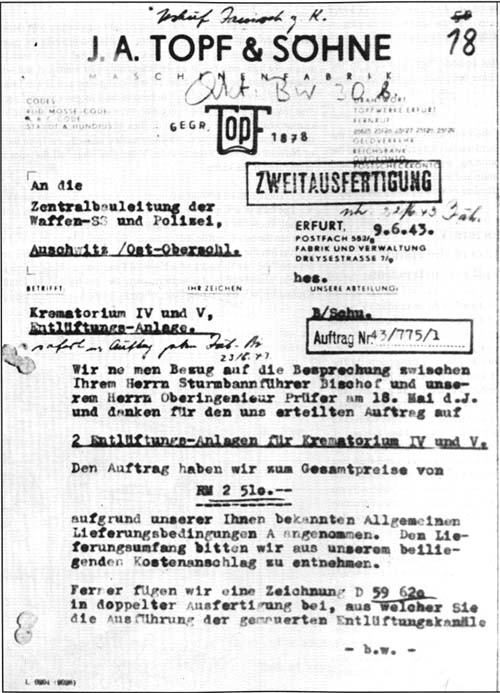| The Hungarian extermination |
In preparation for the Hungarian extermination, the SS had Krematorien II and III overhauled at the end of April 1944. Overwhelmed by the influx of transports, they tried at the beginning of June to bring Krematorien IV and V back into service. They failed with Krematorium IV, but were partly successful with Krematorium V. Even though its furnace worked as it had done earlier, it was not able to rapidly cremate the batches of victims turned out by its gas chambers. It was SS Master Sergeant Otto Moll who took the initiative of digging five small open-air cremation ditches behind Krematorium V. between its north wall and drainage ditch L1. The unconsumed bones had to be smashed to powder, crushed with sledgehammers on a steel plate, another of Moll’s inventions [David Olère portrayed this practice in a sketch. See Document 12a].
Homicidal gassings at Krematorium V, its furnace extinguished, now proceeded as follows (fourth phase): the “unfit for work” entered via the vestibule and undressed in the central room; they were then pushed into the block of (three, later four) gas chambers and killed there; their bodies were dragged by the Sonderkommando to the cremation ditches and burnt in the open air. In good weather, in the summer of 1944, the central undressing room was not used and the victims were made to undress in the open air before being introduced directly into the gas chambers.
Sometimes there was only a small number of victims and Zyklon B was less plentiful than usual. To deal with this kind of situation, the corridor serving the two westernmost rooms was divided in two, in the proportion 1:2, thus forming a fourth small gas chamber of 13 m² (26 m³), in which small groups could be “treated” with a minimum of Zyklon B (one 200 gram can).
At the end of May 1944, most of the Sonderkommando men were transferred from block 11 of the “Men’s Camp” (B.IId) to Krematorium IV, which was converted into a dormitory for them. According to Dragon, there were 700 of them, which would mean that ALL of Krematorium IV except for the furnace room and its annexes was occupied by the prisoners' bunks and no homicidal gassings would have been possible there as from this date. |
| The Polish Resistance photographs |
| Four photographs were taken in the summer of 1944 during the gassing and cremation of a group of Jews at Krematorium V. The camera was introduced clandestinely by a member of the camp resistance movement, David Szmulewski. The pictures were taken by an unknown member of the Sonderkommando, who had to work under extremely difficult conditions in places where he could not be seen by or was not clearly visible to the SS guards in the three watchtowers near the north wall of the Krematorium: first in the northern gas chamber, then in the Birch Wood to the cast of the building, the camera being hidden in his hand while he was out in the open. The two most dangerous moments in this episode were the transfer of the camera from David Szmulewski (on the roof of the gas chambers) to the Sonderkommando man (on the ground) and the reverse process when the pictures had been taken. Only three of these photographs are exploitable [see the study of them in annex]. |
|
Documents 11 and 12
[PMO file BW 30/27, pages 11 and 12] |
 |
Document 11 |
|
| Document 12 |
 |
|
| |
Letter of 9th June 1943 from Messrs Topf & Sons to the Auschwitz Bauleitung following the meeting of 18th May concerning 2 air extraction installations for Krematorien IV and V to he supplied at a total cost of 2,510 RM. Two copies of Topf drawing D 59.620 were enclosed, showing the construction of the brick-built extraction ducts and the arrangement of the suction duct, blower and pressure duct to be supplied by Topf. The electric motors to be used were of 3.5 HP and the system would have had a capacity of 8,000 m³ per hour. The installation was never fitted in either of the two Krematorien. |
|
|

